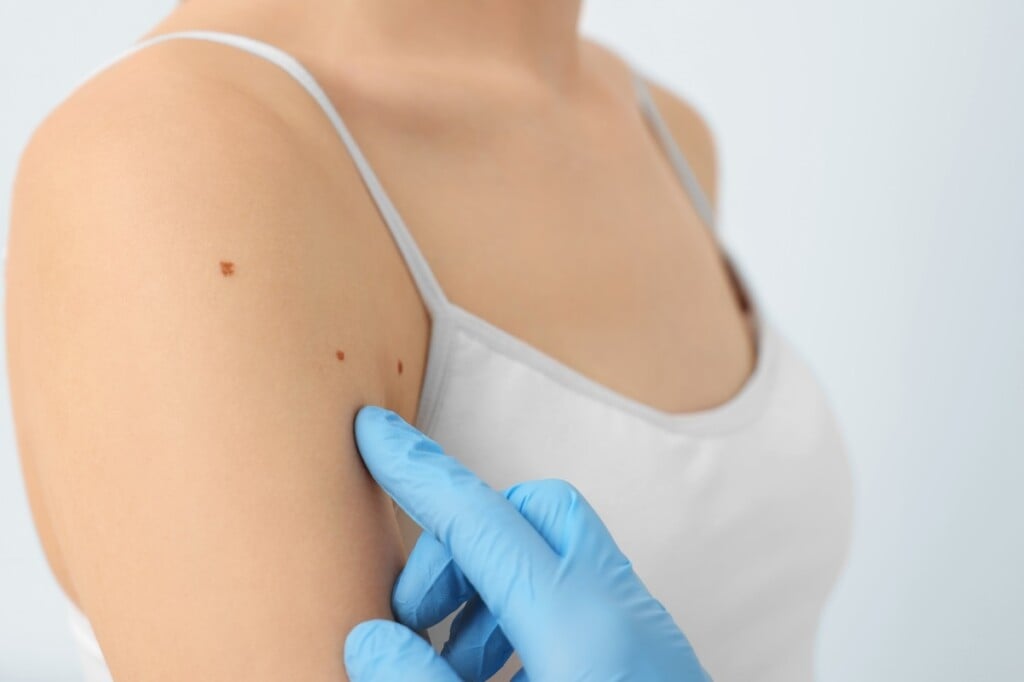The Skin You’re In
A benign bump or a cause for alarm? A Monmouth dermatologist explains when to see an expert if something changes on your epidermis.

Your skin is your largest organ, and it’s the most visible part of you. Exposed to the sun, the elements and other people’s eyes, it can take a lot of abuse, and it goes through some serious changes as you age. Wrinkles, age spots, increased sensitivity, more visible veins—while it may be tempting to write off all of these as inevitable symptoms of Father Time, take caution. Sometimes changes in your skin can be indications of a larger problem.
As Christine Schafer, M.D., a board-certified dermatologist at Little Silver Dermatology in Little Silver, says, “I think people put off a dermatologist visit because there’s always a natural anxiety about the skin exam or over the possibility of a skin biopsy, which can feel scary if someone hasn’t experienced it before. People can also dismiss skin concerns as being insignificant because they don’t understand the dangers of skin cancer and other problems.”
When should you be concerned? MONMOUTH talked to Dr. Schafer about red flags, when to seek out a professional and some solutions that professional can offer.
Changing moles and patches of skin. “There are inevitable skin changes that come with aging, but it’s for something that is new, whether a growth or a brown spot, that one should always be evaluated by a dermatologist,” says Dr. Schafer. A new mole, or an old one changing or growing, can be a sign of skin cancer. “Anything that’s looking different from the rest of the spots on your skin, or anything that’s changing in size, shape or color, is a concern that should be evaluated,” the doctor adds. “You should also keep an eye on anything that isn’t healing. If you have a pimple or a bump you thought was an injury that’s lingering for a couple of weeks, that’s something that should be looked into.”
There are three common types of skin cancer: squamous-cell carcinoma, basal-cell carcinoma and melanoma. Squamous-cell carcinoma and basal-cell carcinoma form in the upper and lower layers of the epidermis, respectively, and are the more common forms. Melanoma develops deeper in the skin, within the cells that give our skin its color, and it’s much more likely to spread and become dangerous than squamous cell or basal-cell carcinoma. Fortunately, says Dr. Schafer, “When caught early, the vast majority of skin cancers can be treated with a simple, in-office, scraping type procedure by a dermatologist, with a minor surgical procedure or with Mohs surgery.”
Often called “the gold standard” for such treatment, Mohs surgery precisely removes the skin cancer layer by layer, preserving the healthy tissue around it. Always, says the doctor, early detection is key. “The earlier a skin cancer is diagnosed, the better, and the easier it is to treat.”
Melanoma more often arises from pre-existing moles than from new ones, and doctors provide the “ABCDs” of identifying them: asymmetry, border, color and diameter. In order, if a preexisting mole starts changing and is different on one side versus the other (asymmetry), begins to develop jagged edges instead of smooth ones (border), is an uneven hue (color) or begins to grow significantly (diameter), that’s a sign you should see a doctor.
Though skin cancer is more likely to develop in places with high sun exposure, such as the face or neck, it’s not limited to those places. “You can get it anywhere on the body,” says Dr. Schafer, who flags the top of the feet as a common problem area that people forget to check on themselves. “I recommend doing skin checks on yourself every couple of months,” she adds. “When you get out of the shower, really look at your skin and notice if anything is new or has changed.”
In addition, as you get older, you may also develop a lipoma, or a raised bump of fatty tissue growth, usually between the skin and the underlying muscle layer. A lipoma feels doughy, is usually not painful and will move with finger pressure. It’s usually not a cause for concern. “Lipomas are very common and often normal,” says the doctor, “but I always tell people to watch them. If one starts changing, growing or hurting, those are reasons to have it looked at.”
Skin irritation. Often, irritated skin just needs some moisturizer and time. But sometimes it needs something more. “Any kind of rash or irritation that lasts longer than a few weeks and doesn’t respond to common-sense measures such as moisturizer, you should get checked out,” says Dr. Schafer. “In addition, if it’s causing a lot of discomfort—if it’s painful or blistering, for instance—I would seek someone out right away.”
If a rash follows a pattern where something may have touched your skin, you may be experiencing an allergic reaction called contact dermatitis, which is produced by contact with something you’re allergic to. “It can be caused by anything from poison ivy to a new cosmetic-product fragrance,” says Dr. Schafer. These reactions are usually treated with creams or oral steroids—and advice to avoid the allergen in the future. Rashes can also be caused by bacterial skin 21 infections (a staph infection, for example), which can cause the skin to look crusted and yellow and are treated with antibiotics, or viral infections such as shingles, which often blister.
Says Dr. Schafer: “There are also genetic inflammation conditions such as eczema and psoriasis. They are chronic, but can present any time in your life.” Eczema and psoriasis both make skin appear to be “scaly,” and need to be treated with either creams or a newer class of medications called biologics, which are derived from living organisms. “Those are different injections, or sometimes pills, that treat that inflammation from the inside out,” says the doctor. “Both conditions cause inflammation internally as well. The biologics calm down general inflammation and are life-changing for patients.” Both conditions are also associated with other health concerns—eczema with allergies and asthma, and psoriasis with arthritis. Addressing the skin issue and inflammation can also sometimes help ease other symptoms of these conditions.
Hair loss. Male- or female-pattern hair loss, the most common cause of baldness, is genetic and results from testosterone shrinking hair follicles until they can’t support hair growth. While there are effective ways of treating that as well, Dr. Schafer says to pay attention if you start losing hair rapidly, or if the loss is accompanied by scalp irritation. “If it’s not a gradual progression over time, if you’re just shedding, then something could be wrong,” she says. “It’s also concerning if your scalp is red or itchy. That’s not a natural part of the aging process—that could be a problem.”
For instance, anemia, low red blood cells or certain thyroid conditions can cause hair loss. The above mentioned eczema and psoriasis can also cause hair loss when spread to the scalp. And there are autoimmune conditions that cause the body to attack its hair. “That’s called alopecia areata,” explains Dr. Schafer. “Your skin is actually attacking your own hair follicles.” Hair loss caused by alopecia areata will manifest in circular patterns, and anti-inflammatory medications can treat it and ensure that hair grows back healthy.
More than anything, Dr. Schafer stresses patient comfort when dealing with everything from skin cancer to a benign lesion. “Skin problems in general, while they are only on the surface of the body, can certainly cause a great deal of discomfort. These symptoms can often be managed efficiently, and early detection is always better.”

